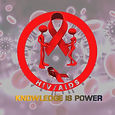THE ANATOMY OF THE VIRUS
HIV belongs to the family of human retroviruses (Retroviridae) and the subfamily Lentiviruses. It is an RNA virus and its hallmark is the reverse transcription of viral RNA to DNA by reverse transcriptase enzyme, a unique characteristic of retroviruses. All the other non-retroviral viruses lead to the transcription of new RNA from a DNA strand. There are tw o types of HIV, HIV-1 and HIV-2 w ith the former being the predominant type in most parts of the world.
HIV virion morphology
The virus detaches from the surface of the host cell membrane by a process called budding. Part of the host cell membrane therefore forms the envelope of the new virion w ith some of the host proteins becoming incorporated into the envelope in the process. Of most significance is the major histocompatibility complex (MHC) class I and II host proteins. The envelope is also studded by specific glycoproteins that facilitate attachment and subsequent entry of the virus into the host cell. These envelope glycoproteins are, the outer membrane glycoprotein (gp120) and the transmembrane glycoprotein (gp41).
On the inside, the envelope is lined by a structural protein called the matrix protein (p17) w hile another structural protein, capsid (p24) forms a cone-shaped casing around the core of the virion. The core consists of two single-stranded RNA molecules w hich form the RNA genome of the virus, and enzymatic proteins, reverse transcriptase, integrase and proteases.
Glycoproteins
The surface glycoprotein, gp120 is attached to the viral membrane via the transmembrane glycoprotein gp41. It recognizes specific receptors called the CD4 receptors on the surface of the target cells. gp41 the transmembrane glycoprotein traverses the virion membrane and mediates fusion of the host and viral membrane thereby allow ing HIV to enter the host cell.
HIV genome
Common to most retroviruses are genes that encode the structural proteins of the virus, Gag-Pol-Env genes. Gag encodes the proteins that form the core of the virion, Env encodes the envelope glycoproteins and Pol encodes the viral enzymes, reverse transcriptase, proteases and integrase. HIV-1 is however more complex than other retroviruses and contains other genes, HIV-regulatory genes w hich code for proteins involved in the regulation of gene expression (tat, rev, nef, vif, vpr, and vpu). Some of these regulatory genes play a role in pathogenesis of HIV disease.
Target cells of HIV
Any cell that expresses the CD4 receptor together with the co-receptor molecules (chemokine receptors) can be a target. The principal targets are the CD4 Tlymphocyte cells (T helper cells), monocytes and macrophage lineage cells. Others with few CD4 receptors are follicular dendritic cells (FDC) and the epidermal Langerhans cells present in the skin.
Normally, tw o surface receptors are required for the virus to gain entry into the host cells. Chemokine receptors (co-receptors for HIV) belong to the large group of seven-transmembrane domain G protein-coupled cellular receptors. The two most important co-receptors for HIV-1 are CCR5 (R5) and CXCR4 (X4). These coreceptors also help in determining the cellular tropism of the HIV-1. The T-tropic HIV-1 strains bind to X4 co-receptor cells, mainly the T-cells w hile the M-tropic strains bind to the R5 co-receptor cells like the macrophages.

.jpg)




